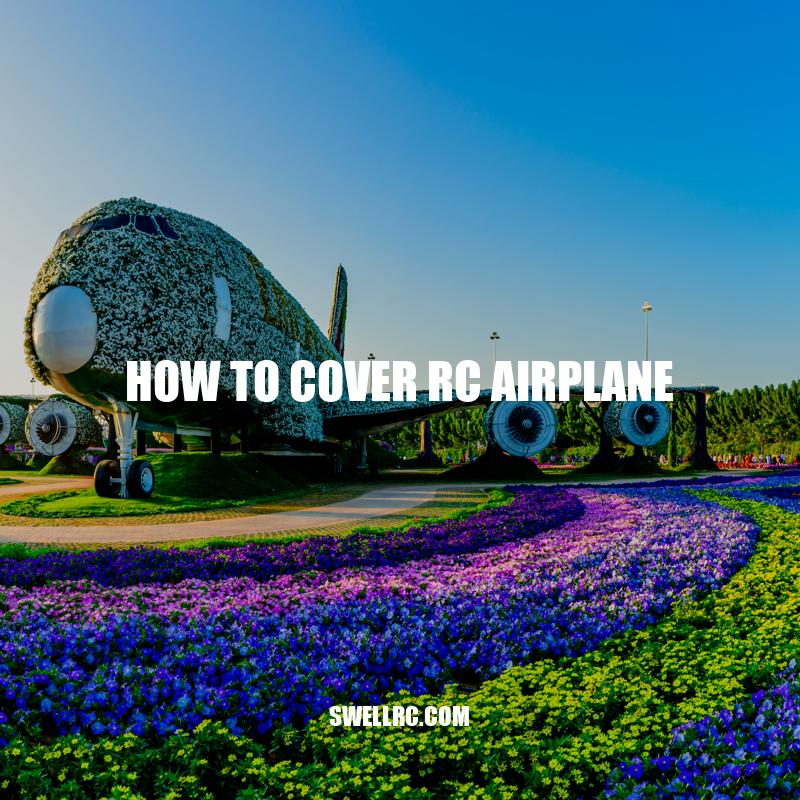Covering RC Airplanes: A Complete Guide
RC airplane covering is a process that every RC airplane enthusiast should consider to protect their airplane from external elements and improve its appearance. Proper aircraft maintenance is important for the safety and longevity of the airplane. One of the essential maintenance practices is covering your airplane. Airplane covering protects the aircraft’s structure from natural elements such as moisture, sunlight, heat, and other environmental impacts. Moreover, it enhances the airplane’s aesthetics, giving the airplane a unique personal touch. However, airplane covering can be challenging if not done with the right materials, tools, and procedures. Therefore, it is crucial to research different covering types and seek advice from experienced builders. In this article, we will guide you on how to cover an airplane correctly, including selecting the right covering material, preparing the airplane, applying the covering material, adding finishing touches, and maintaining your airplane.
Choosing the Right Covering Material
Selecting the right covering material is essential to ensure that the airplane remains protected and looks good.
- Consider the type of airplane, desired finish, and application method
- Plastic coverings are an excellent option for beginners, while fabric coverings are suitable for more experienced builders
- Research different types of coverings such as heat shrinkable coverings or plastic coverings
- Seek advice from experienced builders or online forums on the best covering material to use
RC airplane covering is a vast subject, and selecting the right covering material is essential to ensure a successful project. One popular covering material among RC airplane enthusiasts is the heat shrinkable covering such as Ultracote or Monokote. Others prefer using plastic coverings such as Solarfilm or Solarspan, which are easy to apply but can be less durable. Fabric coverings, such as silk and dope, are the most traditional and offer a unique finish, but these require skills and experience to apply successfully.
Therefore, when selecting the right covering material, it is crucial to consider the type of airplane, level of experience, and desired finish. Online hobby shops such as Tower Hobbies, Horizon Hobby or RC Planet sell different covering materials, and they offer advice on the most suitable materials for your project.
What is the best material to use for an RC plane?
- The best material to use for an RC plane largely depends on the design and purpose of the plane, but some common options include:
- Balsa wood: lightweight and easy to work with, great for beginners or small planes
- Polyurethane foam: strong, lightweight, and versatile; often used in park flyers and larger planes
- Carbon fiber: extremely strong and lightweight, commonly used in high-performance planes
- EPO (Expanded Polyolefin): flexible and durable, ideal for beginner planes or planes that fly in rough conditions
For more information and recommendations on RC plane materials, check out websites such as Flite Test or Horizon Hobby. They offer a wide range of products and resources for hobbyists of all levels.
Preparing the Airplane for Covering
Properly preparing your airplane before covering will ensure that the covering adheres well and looks great in the end.
- Inspect the airplane to check for any loose or damaged areas
- Remove the engine and radio gear, or cover them with plastic wrap to prevent damage or contamination
- Thoroughly clean the airplane to remove any dirt, oil or debris, use a soft-bristled brush or a vacuum cleaner, and then wipe the surface with a clean cloth and rubbing alcohol to remove any oils
- Sand the surface of the airplane to remove any bumps or roughness using a fine-grit sandpaper (320-400 grit) until the surface is smooth
A smooth surface is essential for the covering to adhere properly, and you can use a wooden batten or straight edge and run it over the surface to check for any bump or roughness. If you find any, use fillers or balsa wood to smooth the surface. Additionally, removing the engine, radio gear or other parts that may obstruct during the covering process is essential. You can use tables or stands to will help support the airplane.
| Tools needed for preparing the airplane for covering | |
|---|---|
| A soft-bristled brush or vacuum cleaner |  |
| A fine-grit sandpaper (320-400 grit) |  |
| Rubbing alcohol |  |
| Filler or balsa wood |  |
By following these steps, your airplane will be ready for covering, and you will have a smooth and clean surface to work on.
What do you prepare before you fly?
Here are a few important things to prepare before you take-off on your next trip:
- Check-in for your flight and print out boarding passes if necessary.
- Pack all necessary travel documents such as passport, visa, and any required health certificates.
- Ensure you have all necessary travel essentials such as chargers, headphones, and medications in a carry-on bag.
- Get travel insurance to cover unexpected cancellations, lost luggage or medical emergencies.
- Pre-book airport parking, airport lounges and airport transfers in advance to save time, money, and stress.
Some travel websites like Expedia or Booking.com offer various services to help with these preparations such as booking parking, insurance, and lounge access.
Applying the Covering Material
Applying the covering material is a crucial step in the process, and there are some helpful tips to make sure it looks great:
- Start covering from the center and work your way to the edges to avoid wrinkles or creases
- Secure the covering tautly and reposition any location that develops wrinkles, pull with care and smooth it down
- Using a heat gun or iron will help smooth out wrinkles, but be careful not to melt or damage the covering material
- If your cover starts to wrinkle or develop layers, you can use a heat gun or iron to separate and separate it to release air to help it stretch more
- Watch a few How-to videos on YouTube or read up on some documentation to be sure that you’re doing it right
RC hobbyist websites, like MotionRC or Towerhobbies, offer a range of covering material options and a variety of tools used in covering RC planes. If you don’t have existing tools, those websites also offer the necessary tools, such as film cover iron, heat gun, film trimmer, and other covering tools that you might need.
Follow these tips and use the right tools and materials, and you’ll have yourself an RC airplane that’ll look professionally covered.
Finishing Touches
Once the covering material is applied, it’s time to add finishing touches for a polished look:
- Trim off any excess material for a clean appearance
- Seal the edges of the material with a heat gun or iron to avoid peeling away from the surface
- Apply decals, stickers, or stripes to enhance the aesthetic of the airplane, such as from Stickernerd or Stickers Northwest
- For extra protection, apply clear coat paint as the final layer to preserve the paint job underneath from being scratched or chipped
- Make sure to let the paint dry completely before using the airplane
If you’re looking to add some aesthetic finesse to your RC airplane, there are a variety of decal or sticker designs available online. You can also find the spray paint or clear coat paint from your local hardware store or sites such as Amazon, eBay or Walmart.
Overall, finishing touches will improve the appearance of the aircraft while keeping it secure and protected for an extended period, complementing the effort made to protect the RC airplane.
Maintenance
To ensure that your RC airplane stays protected, performs well, and looks excellent for an extended period, you should adopt proper maintenance habits:
- Clean your airplane regularly using a microfiber cloth and compressed air to remove dirt and debris that may accumulate on its surface.
- Check regularly for any damages or strains on the material and repair accordingly to avoid wear and tear.
- Avoid exposing the plane to moisture or direct sunlight for an extended period, which could cause damage to the paint job, as well as weaken the covering material.
- Store your airplane in a dry and cool space when not in use. Humidity and high temperature may alter the material’s integrity and result in bubbling or peeling off.
- If you notice any loose areas, make sure to glue it or iron it to reattach to the surface to avoid further peeling off.
You can refer to the RC airplane manufacturer’s website or owner manual to get more information about the maintenance requirements and recommended practices. Also, consult with other experienced model airplane enthusiasts in forums or websites like RCGroups.com or HobbyKing to gain insights about best practices and troubleshooting tips.
Maintaining your RC airplane is an excellent practice that guarantees lasting protection against environmental factors and gets the best out of your investment. You can purchase airplane repair kits or covering materials online from RC Planet or HobbyKing to perform quick-fixes and replacements.
Conclusion
Covering your RC airplane not only enhances its appearance but also protects it from environmental elements. With the right covering material and proper application techniques, you can achieve a seamless and durable finish. Proper maintenance practices will ensure that the airplane stays in top condition, providing optimum performance and appearance.
While there are different types of covering materials and methods available, the key is to choose the right one that meets your needs and preferences. Researching the different types of materials, as well as the pros and cons and consulting with experts or other experienced model airplane enthusiasts is an excellent way to gain insights and make an informed decision. Also, following the manufacturer’s instructions or taking help from online tutorials and videos can be beneficial.
Whether you are a seasoned model airplane enthusiast or just starting, covering your RC airplane is a fun and rewarding experience, and with the right tools and materials, anyone can accomplish it. So, go ahead, give it a shot, and see how it can transform your airplane’s appearance and performance.



